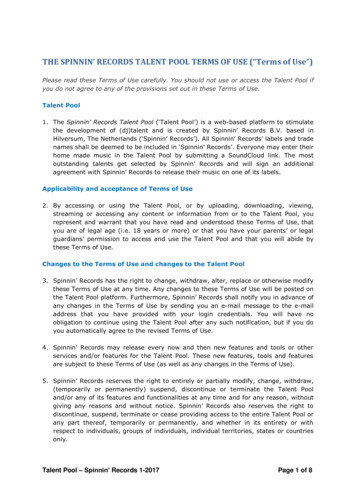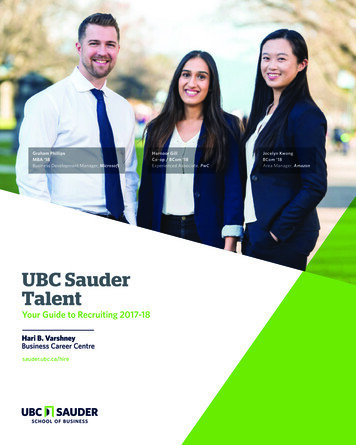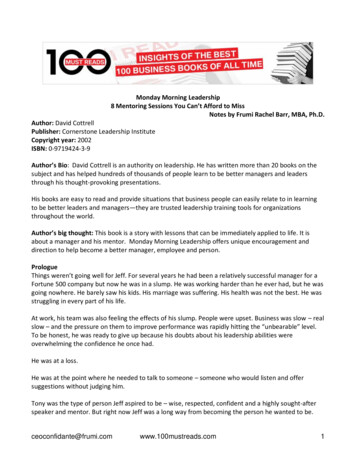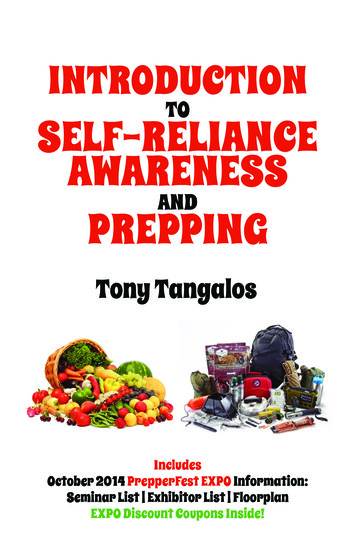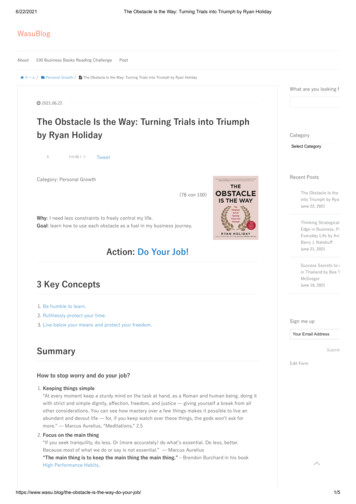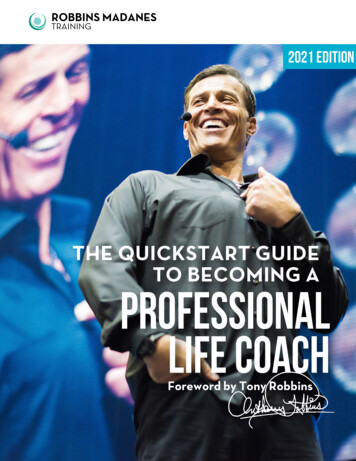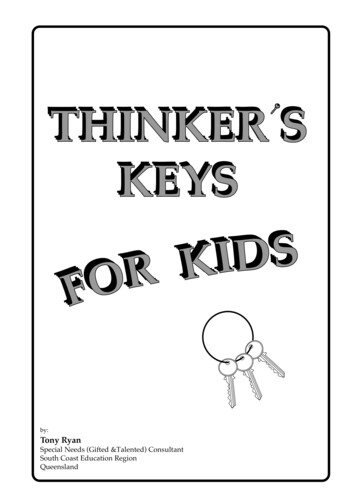
Transcription
by:Tony RyanSpecial Needs (Gifted &Talented) ConsultantSouth Coast Education RegionQueensland
LIMITED REPRODUCTION PERMISSIONPermission is granted to schools or parents who purchase this book to reproduceany part of this material for classroom or personal use.Further duplication is prohibited. 1990
Table of ContentsPageThe Origins .2The Need for Creative Thinking .2The Age of Artificial Intelligence .3Acknowledgements .3General References .4THE THINKER'S KEYS:The Reverse. .5. .5The What IfFigure.i (an example of What If sheet - Ideas Wheel) . 6Figure.ii (reproducible What If sheet- Ideas Wheel) .7The Disadvantages. .8. .8The CombinationThe BAR. .9The Alphabet. .10The Variations. .10The Picture. .11The Prediction. .11. .12The Different UsesThe Ridiculous. .12The Commonality. .13The Question. .13The Brainstorming. .14The Inventions. .14The Brick Wall. .15The Construction. .15The Forced Relationships. .16The Alternative. .16The Interpretation. .17THE THEMES:The Environment .18Australiana .20Outer Space .22Under the Sea .24Transport .26Food .28Dinosaurs .30Christmas .32Communications/Media .34Sport .36Animals .38The Future .40DESIGN YOUR OWN ACTIVITIES .42–1–
THE ORIGINSWhen I initially designed the Thinker’s Keys in the following pages, the impetusfor my ideas came directly from two marvellous books on the teaching of thinking. Thefirst of these was ‘The Thinker’s Toolbox’ (Thornburg and Thornburg, 1989) in which 16different teaching strategies, known as Thinker’s Tools, were outlined for classroomuse. It is these Thinker’s Tools that led directly to the concept of the Thinker’s Keys.The second stimulus for my thinking came from the brilliant ‘Adventures inThinking’ (Joan Dalton, 1986). Among the many excellent features of this book was asection known as ‘The Festival of Practical Ideas’, in which the author presented a hugerange of innovative activities arranged in a thematic format.To me, it appeared quite obvious that the new Thinker’s Keys should be linkedwith the thematic approach to teaching, as outlined in ‘Adventures in Thinking’. As aresult, this booklet has been presented in two integrative sections. In Part A, a briefdescription has been provided for each of the twenty Thinker’s Keys, while in Part B, atotal of twelve themes have been chosen to demonstrate the type of ideas that can begenerated with the Keys.Naturally, there is nothing new about the teaching of thinking or about thethematic approach. Thousands of teachers throughout the world have been applyingthese philosophies for many years. The distinguishing feature of this booklet, however,is that it forms a link between the thinking strategies and the themes in a simplisticand effective manner.THE NEED FOR CREATIVE THINKINGThe majority of the Keys place emphasis upon the development of innovative andcreative thinking. I have done this for three important reasons:1.Creative thinking can be exciting and enjoyable. This active participation can thencreate a positive attitude towards the learning process.2.The stimulation of creativity in learning heightens the emotional link with thatlearning. This emotional involvement boosts the effectiveness of our memorysystems.3.Developing our creative potential will strengthen our ability to cope with change.If there is one thing that we can guarantee into the 21st century, it will be theexponential rate of change that will affect the world. When our thinking is openended and accepting of new ideas, we become much more capable of adapting tothese changing circumstances.–2–
THE AGE OF ARTIFICIAL INTELLIGENCECreative thinking assumes even greater importance when we consider thepotential of artificial intelligence. The world is now well into the Information Age, andcomputers continue to rapidly overtake many of the analytical thinking functions thatwe formerly entrusted to our brains.It is obvious that computers will eventually be able to fulfil most of thesefunctions. Thus, the occupations waiting for today’s students in the 21st century will bethose that computers are not capable of doing. These future occupations are likely toinvolve a strong creative and personal component.Where does this leave today’s students? There is no point in radically altering thepresent curriculum, because rapid change has never worked anywhere, particularly inthe education system. Keeping this point in mind, however, it is important that weintegrate creative activities into our present structures, and provide children withstrong coping mechanisms for their uncertain future.ACKNOWLEDGEMENTSI would like to acknowledge the following people for their marvellouscontribution to the development of my own thinking in the past six years: The many teachers in the South Coast Education region for welcoming me intotheir classrooms, and encouraging me to develop the concepts and ideas in thisbooklet before they were printed; The South Coast Education region consultancy team, who constantly strive for thehighest professional standards in such a positive manner; The state-wide team of consultants for Gifted and Talented Education for theirwonderful support and encouragement; and Joan Dalton and Julie Boyd (Teamlinks Australia), who are simply brilliant.Tony Ryan (October, 1991)–3–
GENERAL REFERENCESCarnow, G.A. and Gibson, C.Prolific Thinkers Guide,Dale Seymour Publications, USA, 1987.Dalton, J.Adventures in Thinking,Thomas Nelson, Australia, 1985de Bono, E.Po : Beyond Yes and No,Penguin, 1972.McCormack, A.J.Inventors Workshop,Hawker Brownlow Education, Aust, 1989.Naisbitt, J. and Aburdene, P.Re-inventing the Corporation,Warner Books, 1985.Thornburg, P. and Thornburg, D. The Thinker's Toolbox,Dale Seymour Publications, USA, 1989.von Oech, R.A Whack On The Side Of The Head : HowTo Unlock Your Mind For Innovation,Angus and Robertson, USA, 1984.With special thanks to Cheryll Beaumont, whose superb secretarial abilitieswere admirably demonstrated in the compilation of this booklet.–4–
THE EXPLANATION OF THE THINKER’S KEYS1.The REVERSEPlace words such as cannot, never and not in sentences which are commonlydisplayed in a listing format.THE JUSTIFICATION:Students are too often required to regurgitate endless lists of facts. Moving in theopposite direction still requires a sound knowledge base, but it forces students to think.THE EXAMPLE:Name 10 things that you could not clean.List 5 sounds that you have never heard.Name 10 things that you could not photograph.2.The WHAT IFYou can ask virtually any What If question. They can be either serious or frivolous. Oneexcellent means of displaying ideas from this key is to draw up an Ideas Wheel.THE JUSTIFICATION:Great for introducing an area of study, and for tapping into the students’ knowledgebase. It also generates loads of innovative ideas.THE EXAMPLE:1. What if the price of petrol was immediately doubled?2. What if all cars turned into skateboards?Now construct an Ideas Wheel. Place the base statement in the middle circle, and put 5consequences of that event in the 5 outer circles.Then deal with each of the 5 outer circles in turn. Put 3 consequences of each of theseinto the smaller circles. (see Figures i and ii)–5–
huge rise in trafficinfringementsmore licencetesting centres–6–easier tofind yourskateboardless usageof medicationcrutchcompaniesprofitableAll carsturned intoskateboardsmore roomfor skateboardrampsobsoletefitness centresEveryonewould befitterDriving agereduced from17 to 5HigherinjuryratemoreBloodBanksCar parkswould bemuch smallerovercrowdedhospitalsless walkingwhen shoppingFigure . ipeople wouldlive longerconstant updatingof licence cslessconservationists
For use in classroomsFigure . ii–7–
3.The DISADVANTAGESChoose an object, eg an umbrella, or a practice, eg playground duty, and list a number ofits disadvantages. Then list some ways of correcting, or eliminating these disadvantages.THE JUSTIFICATION:We often accept the inadequacies of many products, without really considering how theycan be improved. Practise this key and you will be amazed at the number of everydayproducts which can be further developed.THE EXAMPLE:An Umbrella:The Disadvantages4.The ImprovementsThe sharp sections can poke you in the eye.Glue flat erasers onto the end ofeach one.They take up too much room,even when folded.Develop a series of locking hingesalong the length of the umbrella.Water drips onto your shoes.Attach an overhanging plastic sheetto the edges of the umbrella.The COMBINATIONList the attributes of 2 dissimilar objects (one within your area of study, one outside),then combine the attributes into a single object.THE JUSTIFICATION:Many important inventions, such as the disposable razor (the concept of loading bulletsinto a rifle, combined with a normal razor) and the first printing press (the wine pressand the coin punch) were created in this way.THE EXAMPLE:A leaf and a mousetrap.The LeafThe MousetrapThey change colours through the year.They are made of wood and wireInsects often eat them.They can kill mice.There are millions of them.They can be left in lots of places.–8–
THE COMBINATIONS:1. A miniature mousetrap for placing on leaves, that can kill insects when they try to eatthe leaf.2. Mousetraps that can change colour and blend in with the surface on which they areplaced.5.The B A RThe following acronym, or ladder of words, can be used by different age groups (rangingfrom Yr 1 to adults) to reinvent or redesign everyday objects.THE JUSTIFICATION:A practical step-by-step strategy for developing innovative and highly unusual products.This type of strategy is often used in today’s hightech product development laboratoriesto create new products for the market.The Ladder is:B iggerA ddR eplaceTHE EXAMPLE:B A R a skateboard. Ask the students todraw a standard skateboard, and thendirect them through the steps one at a time.Here's one series of possibilities:B iggerExtend the rear of the skateboard, making it much bigger, and put someshelves on it for storage space. Place a counterweight on the front to balanceit out.A ddAdd a small rocket motor, which can be controlled with a foot throttle nearthe back of the skateboard.R eplaceReplace the wheels with a small hovercraft unit, which is controlled by ahand-held rotating device.It is very important that SILLY and INNOVATIVE ideas are encouraged. Very few newideas emerge from predictable and tedious efforts.–9–
6.The ALPHABETChoose an object or general category of objects which features in the area of study andcompile a list of words from A to Z which have some relevance to the object/s. Then tryto expand on some ideas which link with each of the words.THE JUSTIFICATION:Using the alphabetical format clarifies students’ thinking. It is a sorting process which ismade easier by considering one aspect at a time.THE EXAMPLE:Sport (specifically tennis)A. Antbed courts - does this mean that ants can play tennis while in bed?; perhaps aminiature game of tennis could be devised as a board game, with each of the playersbeing activated by remote control.B. Bouncing - could tennis racquets be constructed of a special rubber so that they couldbounce as well?; this feature could be included in a new version of tennis. Perhapsthe rules would require each player to bounce the racquet after every shot is played.Then continue with C through to Z. If the students draw a blank with a particular letter,simply move on, and return to that letter at a later stage.In a more simplified version, merely list single objects from A to Z, e.g. Foods:A - artichokeB - beetrootetc.7.The VARIATIONSThis key employs a special group of words. Start each question with “How many wayscan you ”THE JUSTIFICATION:Another one for expanding your thinking. Some very practical ideas often result fromusage of this key.THE EXAMPLE:How many ways can you: paint a housewash an elephantmake new friendsturn a TV on– 10 –
8.The PICTUREThe teacher draws a simple diagram which has no relevance to the area of study and thestudents then try to work out ways in which it could be linked with that area. As aninteresting imaginative writing exercise, ask the students to compile a list of 10 thingsthat the diagram could represent.THE JUSTIFICATION:Research strongly indicates that the development of visualization capacities will enhancelearning in virtually all fields of study.THE EXAMPLE:Outer Space:Figure 2an overloaded UFO carrying Christmas treesa space monster breaking out of its shell9.The PREDICTIONAsk for a series of predictions in regard to a particular situation, product or set ofcircumstances.THE JUSTIFICATION:Attempting to predict the future is not the timewaster that some would lead us to believe.The journey is always easier if you know where you are going.THE EXAMPLE:1. Predict how schools will operate in 100 years.2. Predict 5 present day household appliances which will be obsolete in 20 years time.3. Predict the power source of the family car by the year 2020.For Example N 3:a. combination electric/petrol/nuclear fission, with the driver determining thechoice before the start of the journey.b. superstrength rubber bands which are wound up with a vintage car crankmechanism.c. satellite electromagnetic directional devices, drawing a car along a course whichhas been predetermined by the vehicle’s onboard computer.– 11 –
10. The DIFFERENT USESPut your imagination to work and list some widely different uses for a chosen object fromyour area of study.THE JUSTIFICATION:The concept of recycling is an important one here. This key is worth applying to many ofour everyday (and often disposable) products.THE EXAMPLE:Find 10 uses for red plastic noses.1. Place them in your strawberry patch to give a false impression of the number ofstrawberries.2. Use them as face masks for mice when they undertake a cheese factory robbery.11. The RIDICULOUSMake a ridiculous statement that would be virtually impossible to implement, and thenattempt to actually substantiate it.THE JUSTIFICATION:The expressions ‘It’s not possible’ and ‘That’s ridiculous’ often prevent thedevelopment of many excellent ideas. Learn to break through them.THE EXAMPLE:“The government should buy a brand new car for every taxpayer.”Some consequences:1. This would provide an incredible boost for the local car industry.2. With so many more people being employed, unemployment benefits would not needto be paid by the taxpayer.3. More money earned from wages would be injected into the economy and would boosta wide variety of businesses.4. Less accidents would be caused by unroadworthy cars, with a subsequent lowering ofcosts associated with accidents.5. Cars would be more fuel-efficient because of their modern design, leading to areduction in air pollution and less wastage of petrol.– 12 –
12. The COMMONALITYDecide upon 2 objects which would generally have nothing in common, and try tooutline some points of commonality between them.THE JUSTIFICATION:Another mindstretcher. Great for creative ideas as well as the development of unusualconcepts.THE EXAMPLE:Ayer’s Rock and the Pacific Ocean:They both change colour through the day.They both have a rough surface.They are both tourist attractions.You can’t drive cars on either of them.When the Flat Earth theory was in vogue, youcould have fallen off both of them.13. The QUESTIONStart with the answer, and try to list 5 questions which could be linked with that answeronly.THE JUSTIFICATION:An excellent break from the pattern of the teacher asking all of the questions. Studentsstill need to demonstrate a solid knowledge base.THE EXAMPLE:The answer is MIDNIGHT.1. When is it 12 hours after midday?2. When did Cinderella’s coach turn into a pumpkin?3. What word is spelt M-I-D-N-I-G-H-T?– 13 –
14. The BRAINSTORMINGState a problem which needs to be solved and brainstorm a list of solutions. Start thebrainstorm statement with the words ‘How to .’.THE JUSTIFICATION:Great for solutions to everyday problems. Make sure that the freedom offered within therules is available to all participants.THE RULES OF BRAINSTORMING:1. Think of as many ideas as you can; don’t hesitate and consider the implications;simply write them down.2. Unusual or silly ideas are acceptable.3. ‘Tagging’ onto other people’s ideas is encouraged.4. No criticism of any ideas is allowed.The Example:How to encourage people not to drive their cars to work.Some possible solutions:1. Offer monetary incentives to drivers with 3 or more passengers.2. Introduce a wide range of work-at-home schemes.3. Revert to pedal cars so that driving requires a much harder effort.4. Provide a financial incentive for driving less often, by basing the annualregistration fee on the number of kilometres driven rather than the presentstandard fee for all vehicles.5. Triple the price of petrol to provide further discouragement and direct the extrataxes towards the design of top quality public transport systems.6. Place wooden seats in cars.15. The INVENTIONSEncourage students to develop inventions which are constructed in an unusual manner.The first step would be to outline the product on paper, which would then lead intopossible construction.THE JUSTIFICATION:Kids (and grownups too) love to invent things if given the opportunity. Tragically, theopportunities in today’s society seem to be growing fewer and fewer.THE EXAMPLE:Invent some or all of the following 1. An eggshell peeler.2. A combination knife and fork.3. Devices which would - catch mosquitoesmake your beddo the ironingcomb your hairwake you up in the morning– 14 –
16. The BRICK WALLMake a statement which could not generally be questioned or disputed, and then try tobreak down the wall by outlining other ways of dealing with the situation.THE JUSTIFICATION:We often give in too quickly when we question many of the world’s present situations.Practise the development of alternative strategies.THE EXAMPLE:Governments need to collect taxes in order to provide necessary services.Some Alternatives:1. Every government employee, without exception, could become an individualcontractor and be paid directly for a service as a customer requires it.2. People could pay for government services by bartering their own skills for a setnumber of hours each week rather than paying with their taxes.3. Every working person could be rostered to work in a government department forone day each week.4. Break the entire nation into community groups of 500 people with each groupbeing responsible for provision of their own services.17. The CONSTRUCTIONSet up a wide variety of construction problem-solving tasks and use lots of readilyavailable materials.THE JUSTIFICATION:Here’s an example of really practical creative thinking. It goes hand in hand withoutright fun. Try to encourage the development of the ’See/Plan/Do/Check‘ problemsolving strategy.THE EXAMPLE:1. Build the highest possible self-supporting structure.Materials: 10 straws and 4 rubber bands.2. Build a platform which will suspend a house brick as high as possible in the air.Materials: One house brick, 10 straws and some sticky tape.3. Build the ‘Story Bridge’ - a book placed as high as possible on a straw platform.Materials: a book, 10 straws and some sticky tape.4. Propel a balloon as far as possible through the air.Materials: One balloon, one straw, some sticky tape, a ball of string and a pair of scissors.5. Build the highest possible self-supporting structure.Materials: One sheet of newspaper, some sticky tape and a pair of scissors.6. Place a rubber band as far from the edge of a desk as possible.Materials: 10 iceblock sticks and 6 rubber bands.7. Balance a marble as high in the air as possible.Materials: One marble, 20 straws and one paper clip.– 15 –
18. The FORCED RELATIONSHIPSDevelop a solution to a problem by employing a number of dissimilar objects.For Years 1/2- one objectFor Years 3/4- two objectsFor Years 5/6/7- three objectsFor Years 8-12- four objectsTHE JUSTIFICATION:The dimensions of problem-solving are expanded dramatically with this key. Neverunderestimate the importance of constantly developing alternative strategies.THE EXAMPLE:A Problem :You need to retrieve your kite from a very tall tree by using: a packet of Mintiesa hairbrusha comicA Solution:Melt the Minties and stick them on your hands and feet to give extra grip whenclimbing. When you are near the kite, throw the hairbrush to dislodge it and make itfall. Then stick the comic pages together with the Minties and construct a parachutefor getting down to the ground.19. The ALTERNATIVEList ways in which to complete a task without using the normal tools or implements.THE JUSTIFICATION:Necessity is the mother of invention. Take away the normal tool and spark someinnovative solutions.THE EXAMPLE:Work out 3 ways to-clean your teeth without a toothbrushcook toast without a toasterpaint a chair without a paintbrushmow the lawn without a mower– 16 –
20. The INTERPRETATIONDescribe an unusual situation and then think of some different explanations for theexistence of that situation.THE JUSTIFICATION:Another innovative thinking exercise. Develops the ability to consider a wide range ofconsequences.THE EXAMPLE:Your neighbour is making large circles in his backyard by pouring sump oil from a can.Some Explanations:1. He is a disguised alien and is sending cryptic messages to his friends in outer space.2. He considers himself to be another Pro Hart, and he will soon be rolling around in thegrass, attempting to create an environmental masterpiece.3. He has had a fixation for circles since his childhood, and later will be seen dancingaround the circles in the light of the full moon.– 17 –
THE ENVIRONMENT1. The REVERSE2. The WHAT IFWhat if:List 10 places that cannotbe destroyed by humansThe world's populationimmediately doubled3. The DISADVANTAGES4. The COMBINATIONList disadvantages of,and improvements to:List attributes of both, then combine:A rainforest vineanda torch batteryA watering can5.The ALPHABET6.The B A RBeautiful placesin the worldA glass greenhouse7. The VARIATIONS8. The PICTUREHow many ways can you:Clean up oil spills9.The PREDICTION10. The DIFFERENT USESFind 10 different uses for:Name 5 world wide industrieswhich will probably notexist in 20 years 1990 Tony RyanDebris from acleared rainforest– 18 –
THE ENVIRONMENT11. The RIDICULOUS12. The COMMONALITYTry to justify this statement:Find common points between:A flyswatteranda car tyreBy law, every householdmust recycle everypossible part of rubbish13. The QUESTION14. The BRAINSTORMINGGive 5 questions for:Brainstorm solutions for:How to encourage peopleto plant more trees" The Antarctic "15. The INVENTIONS16. The BRICK WALLDesign a machine for:Consider alternatives to:removing oil frompenguinsEveryone has to live in theirown house on a large block of land17. The CONSTRUCTIONConstruct a :SeedplanterMaterialsa strawa 20 piece20 iceblock stickssticky tape:18. The FORCED RELATIONSHIPSProtect the last remaining Blue Whale,by using: a pack of cardsa sewing machinea squash ball19. The ALTERNATIVE20. The INTERPRETATIONSWork out 3 ways to:Give 3 possible explanations for:The Great Barrier Reef Marine Parkhas been closed to all visitorsfor 5 years.remove leaves from your lawnwithout using a rake.– 19 – 1990 Tony Ryan
AUSTRALIANA1. The REVERSE2. The WHAT IFWhat if:List 10 things that you willnever see in Australia.all kangaroos disappeared3. The DISADVANTAGES4. The COMBINATIONList disadvantages of,and improvements to:List attributes of both, then combine:An old Holdenandan iceblockthe Hills rotary hoist clothes line.5.The ALPHABET6.The B A RAustralian leisure activitiesa camping tent7. The VARIATIONS8. The 6123456How many ways can you:connect Tasmania to the mainland9.The 1234512345123451234512345123451234510. The DIFFERENT USESFind 10 different uses for:Name 5 Australian creatures whichwill be extinct within 30 years. 1990 Tony RyanA Kylie Minogue record– 20 –
AUSTRALIANA11. The RIDICULOUS12. The COMMONALITYTry to justify this statement:Find common points between:Ayers Rock should be blown up,with the fragments being sold assouvenirs throughout the world.Droughtsand 2 coins13. The QUESTION14. The BRAINSTORMINGGive 5 questions for:Brainstorm solutions for:" A meat pie "How to prevent erosion15. The INVENTIONS16. The BRICK WALLDesign a machine for:Consider alternatives to:weekend BBQsicing lamingtons17. The CONSTRUCTION18. The FORCED RELATIONSHIPSConstruct a : trap for a redback spiderCatch a bunyip,Materials: one sheet of newspaper10 rubber bandssticky tapescissorsby using: a T.A.B. betting ticketa lamingtona Drizabone overcoat19. The ALTERNATIVE20. The INTERPRETATIONSWork out 3 ways to:Give 3 possible explanations for:The Prime Minister is standing on top ofthe Sydney Harbour Bridge, holding ameat pie in one hand and aboomerang in the other.paint the Opera House,without brushes or paint rollers.– 21 – 1990 Tony Ryan
OUTER SPACE1. The REVERSE2. The WHAT IFWhat if:List 10 outer space objects thatwe cannot see in the night sky.the sun disappeared3. The DISADVANTAGES4. The COMBINATIONList disadvantages of,and improvements to:List attributes of both, then combine:A moonbuggyanda pair of scissorsA spacesuit5.The ALPHABET6.The B A RThe Space ShuttleAny objects in space7. The VARIATIONS8. The PICTUREHow many ways can you:contact a rocket in stationaryorbit above the Earth9.The PREDICTION10. The DIFFERENT USESFind 10 different uses for:SunlightHow will rockets be powered in 50 years? 1990 Tony Ryan– 22 –
OUTER SPACE11. The RIDICULOUS12. The COMMONALITYTry to justify this statement:Find common points between:A rocket control panelanda sewing machineEveryone should be taken for aspace shuttle trip into outer space.13. The QUESTION14. The BRAINSTORMINGGive 5 questions for:Brainstorm solutions for:How to get rid of the space junk floatingaround in our upper atmosphere." A Martian "15. The INVENTIONS16. The BRICK WALLDesign a machine for:Consider alternatives to:Launching rockets with a hugeamount of noise and fuel.watering potplants in a space station17. The CONSTRU
When I initially designed the Thinker’s Keys in the following pages, the impetus for my ideas came directly from two marvellous books on the teaching of thinking. The first of these was ‘The Thinker’s Toolbox’ (Thornburg and Thornburg, 1989) in which 16 different teaching strategies, known a
